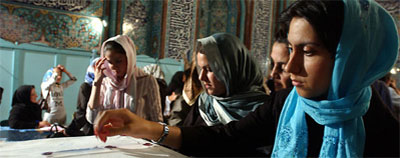
Real change can result from elections in Iran as long as there is a home grown democratic heart beating within the theocratic Republic. But for how long will that be the case?
Iran may not be a liberal democracy but it is certainly a far cry from those fake Democratic Republics that littered the world before 1989. A representative democracy grafted onto a theocracy, the Islamic Republic is a unique specimen in the menagerie of political systems from Uruk, Constantinople and Geneva to Athens, Philadelphia and Moscow.
The Iranian parliamentary elections of 14 March 2008 perpetuated the fractious pattern of the presidential elections of 2005, with splinter groups growing within both “principalist” and reformist camps.
The “principalists” were unable to keep a powerful triumvirate of pragmatic conservatives (the mayor of Tehran, Mohammad Bagher Ghalibaf, the former nuclear negotiator, Ali Larijani and the former Revolutionary Guard Commander, Mohsen Rezaie) from leaving the strict conservative coalition that included President Ahmedinajad. The reformist camp was also cleaved into the eponymous followers of former President Khatami and the National Confidence party of the former Speaker of the Parliament, Mahdi Karrubi.
Given the good showing of the reformist camp, this group can choose to join forces with “independents” (candidates who chose not to affiliate themselves with existing camps) and pragmatic conservatives to shovel sand in the gears of President Ahmadinejad’s polarising economic practices, management style and foreign policy.
The Iranian theocracy runs on the legitimating fuel of annual democratic elections. Of course the democratic component of the Islamic polity has to be kept in check. A theocratic Supreme Court (Guardian Council) vets the candidates before and selectively adjudicates voting irregularities after each election. During elections the state militias of Basij campaign for the personal choice of the theocratic Supreme Leader.
In the recent elections, the disqualification of reformers removed well-known challengers from more than one-third of the 290 seats at the parliament and replaced them on the ballot with less-known reformist candidates with little chance of winning. After the elections, both reformist factions vociferously objected to the results.
The question is why Iranians participate in a “manipulated” election. The answer is simple. Voting is a rational choice: the benefits of participation outweigh its costs. Procedurally speaking, participation in elections prevents total domination by the theocrats, increases transparency and ensures a modicum of circulation of elites at the lower rungs of the system.
Of course there is always an outside (but real) chance of a sudden upset. It is true that the system is altered to benefit theocracy, but a bit of luck and a huge landslide can overwhelm the theocratic stopgaps and lead to historical victories, such as that enjoyed by Mohammad Khatami in 1997 and 2001.
Lack of alternatives is another factor in the calculus of voting in Iran. Revolution against the regime is out of the question for a nation that trod upon that perilous path a generation ago. Nor is it possible to deny legitimacy to the system by an electoral boycott – which requires a campaign that may never be allowed in Iran. In short, Iranians calculate that exercising their right to vote is worth imparting a patina of legitimacy to the system, at least for the time being.
But what about in the long run?
Trends in voting don’t seem to favour the current symbiosis between democracy and theocracy. Natural democratic processes erode strict theocratic rule requiring ever-stricter legal and extra legal measures and “election engineering”. An increase in such interventions will discourage mass participation, which currently hovers around 55 percent.
In the cities where voting is a political act rather than an expression of ethnic solidarity or procurement of cash for local projects, participation has fallen to 30 percent. It is true that low participation favours the right wing which relies on its steady 20 percent population base.
But the recent election shows that in the cities even the supposedly solid conservative base has been thinning. It is therefore possible to extrapolate that Iran is facing increasing voter apathy that will likely disrupt the delicate balance of theocracy and democracy, possibly unleashing a crisis of legitimacy in the Islamic Republic. This is a great liability in a nation that only three decades ago overthrew another powerful but unpopular regime.
Reason and recent regional experience suggest that sustainable political change cannot be dictated to the Middle East from without. There are two survival scenarios for the Islamic Republic and both of them are stories of slow transubstantiation: in one version reformers will prevail, and, having learned their lessons from the Khatami years, rigorously carry through their transformative democratic changes. In another, gradual democratisation, and its inevitable concomitant – the increasing ceremonialisation of theocracy – will result from the acumen of a Supreme Leader who finds reigning as the symbol of the unity of church and state preferable to radical destabilisation.
Ahmad Sadri is a professor of sociology and the Gorter Chair of Islamic World Studies at Lake Forest College. This article was first published in Common Ground News Service (CGNews) commongroundnews.org.






